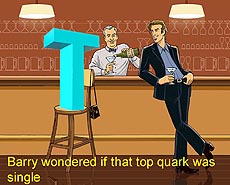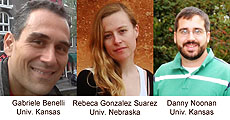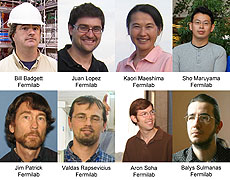Is it single?
 |
| Finding top quarks in pairs is easy, while finding single top quarks is much tricker. In today's column, CMS announces the discovery of a single top quark that was created in a very challenging way. |
Almost all scientists hope to find something that causes us to rewrite the textbooks, but there is also a class of discoveries a little less groundbreaking but still important and intellectually satisfying. In particle physics, these are predictions of the Standard Model that have not yet been confirmed.
When the LHC turned on, the first order of business was to rediscover the Standard Model — first to find jets, then W and Z bosons and eventually the heaviest known particle: top quarks. You may recall that top quarks were first discovered at the Tevatron in 1995 and studied over the next decade and a half. With higher energies and brighter beams, finding top quarks is now pretty easy. In fact, the LHC has been called a top factory.
Top quarks are generally produced in pairs, with one top quark and one top antiquark. This is how the particle was first observed. However the Standard Model also predicted that via the weak nuclear force, single top quarks could be produced. This phenomenon was discovered at the Tevatron and then confirmed by the LHC.
There are a couple of ways to make single top quarks, but one predicted way had not been observed by any experiment. This is the production of a single top quark with a W boson. One way to make this combination is to create a bottom quark with a ridiculously large mass, which then decays into a top quark and a W boson. In classical physics, creating a temporarily heavy bottom quark is a silly idea, but in quantum mechanics, it's quite sensible as long as the bottom quark doesn't exist for very long.
The fact that this process had not been seen meant that the first group to see it would get the bragging rights that go along with being able to publish any paper whose title starts with "Observation of ..." Naturally, both CMS and ATLAS started looking for this predicted process.
Using data taken in 2011, both ATLAS and CMS found evidence for this kind of top quark production, with ATLAS making the first announcement. In particle physics lingo, "Evidence for ..." means that it looks like something was found, but you can't be 100 percent sure. More data was needed.
(According to particle physics culture, "evidence" means scientists saw something at the three-sigma level, or that what they saw could have happened by accident about one time in 740. "Observation" is equivalent to discovery. It means scientists saw something at the five-sigma level, or that what they observed could happen by accident one time in 3.5 million. This video helps clarify the jargon.)
Recently, the CMS experiment submitted a paper for publication that announced the observation of collisions in which a single top quark and a W boson were made. A new discovery has now been added to the list of CMS' accomplishments.
—Don Lincoln
 |
| These US CMS scientists contributed to this analysis. |
 |
| These physicists contribute to building and supporting Web-based monitoring tools for CMS operations. Using these tools, the data is monitored in real time, allowing scientists to correct problems immediately. |
|